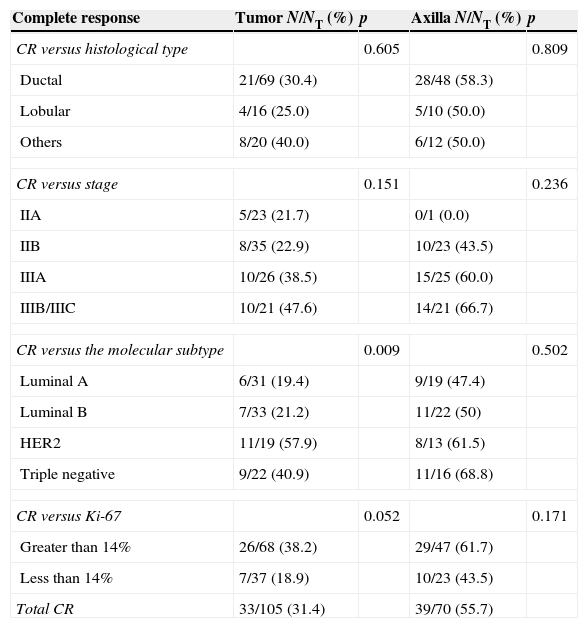To compare axillary involvement (N+) at initial staging in locally advanced breast cancer (LABC) with axillary lymphadenectomy histologic results after neoadjuvant chemotherapy treatment (NeoChemo).
Material and methodsRetrospective study between November 2011 and September 2013 of LABC cases treated with neoadjuvant chemotherapy based on docetaxel (associated with trastuzumab in HER2-positive cases and carboplatin/adriamycin in HER2-negative cases). Those clinically or radiologically suspected cases of axillary involvement were histologically confirmed. When there was no suspicion of axillary involvement, sentinel lymph node radioguided biopsy (SLNRB) was performed using intradermal injection of 99mTc-nanocolloid albumin prior to neoadjuvant treatment. Axillary lymphadenectomy after NeoChemo was undertaken in all cases with positive axilla. Final pathologic response was classified as complete (pCR) when there was no evidence of tumoral disease and as non-pathologic complete response (no pCR) in the opposite case.
ResultsA total of 346 patients treated with docetaxel were reviewed, identifying 105 LABC. Axillary involvement at initial staging was detected in 70 (67%) before starting NeoChemo. From these 70, 73% (n=51) were N+ (fine needle biopsy and/or biopsy) and the remaining 19 (27%) were occult N+ detected by SLNRB. Axillary lymphadenectomy detected pCR in 56% (39/70), increasing up to 84% pCR when initial N+ status was reached using SNLB. On the other hand, when N+ was detected using fine needle biopsy/lymph biopsy, pCR was only 45%.
ConclusionMore than 50% of women affected by locally advanced breast cancer with tumoral axillary involvement at initial diagnosis present free metastatic axilla after therapeutic neoadjuvant chemotherapy effect. This increases up to almost 90% in case of occult metastatic axilla detected with sentinel node biopsy prior to starting neoadjuvant chemotherapy.
Comparar la afectación axilar (N+) al diagnóstico en el cáncer de mama localmente avanzado (CMLA), con el resultado histopatológico en la axila tras el tratamiento quimioterápico neoadyuvante (QTN).
Material y métodosEstudio retrospectivo entre noviembre de 2011 y septiembre de 2013 de los CMLA tratadas con QTN basada en docetaxel (asociando trastuzumab en los casos HER2 positivos y carboplatino/adriamicina si HER2 negativos). Los casos con sospecha clínica/radiológica de N+ se confirmaron histológicamente. Si no existía sospecha, se estadificó con la técnica de biopsia radioguiada del ganglio centinela (BRGC), mediante la inyección de 99mTc-nanocoloide de albúmina, previa a la QTN. En los casos N+ se realizó linfadenectomía axilar (LA) tras QTN. Clasificamos la respuesta patológica final como completa (RCp) cuando no hubo evidencia de enfermedad tumoral y como no respuesta patológica (NRp) en caso contrario.
ResultadosRevisamos 346 pacientes tratados con docetaxel, donde identificamos 105 CMLA. En 70 (67%) se evidenció infiltración tumoral axilar antes de iniciar la QTN. De estas, el 73% (n=51) presentaban N+ por punción-aspiración con aguja fina (PAAF) y/o biopsia ganglionar, y las restantes 19 (27%) presentaban N+ oculta demostrada por la BRGC. La LA evidenció RCp axilar en el 56% (39/70); aumentando hasta un 84% cuando el estatus inicial N+ se alcanzó por BRGC, frente a un 45% cuando se llegó al diagnóstico de N+ por PAAF/biopsia ganglionar.
ConclusiónMás de la mitad de las mujeres con cáncer de mama localmente avanzado con afectación tumoral axilar al diagnóstico presentan axilas libres de enfermedad metastásica tras el efecto terapéutico de la quimioterapia neoadyuvante. Esto aumenta hasta casi el 90% cuando se trata de axilas metastásicas ocultas detectadas mediante el ganglio centinela antes de iniciar la quimioterapia neoadyuvante.
Article
If you experience access problems, you can contact the SEMNIM Technical Secretariat by email at secretaria.tecnica@semnim.es or by phone at +34 619 594 780.

Revista Española de Medicina Nuclear e Imagen Molecular (English Edition)









